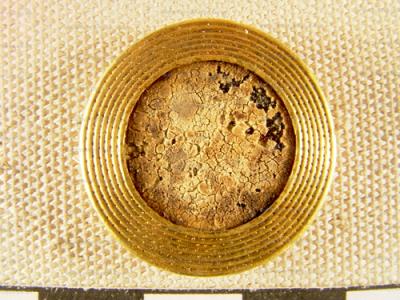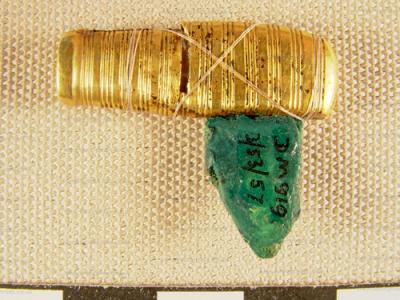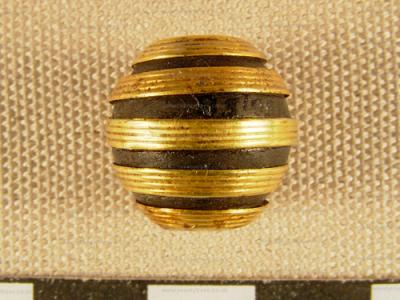Wiltshire Archaeological Magazine 1907 V35 Pages 1-20
Wiltshire Archaeological Magazine 1907 V35 Pages 1-20 is in Wiltshire Archaeological Magazine 1907 V35.
Notes on the Opening of a Bronze Age Barrow at Manton [Manton Barrow aka Preshute G1a [Map]], near Marlborough By Mrs M E Cunnington (age 37).
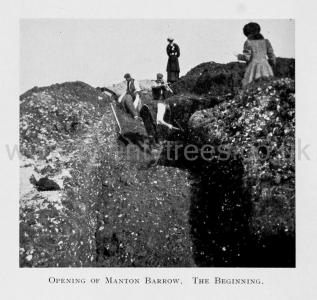 Opening of the Manton Barrow. The Beginning.
Opening of the Manton Barrow. The Beginning.
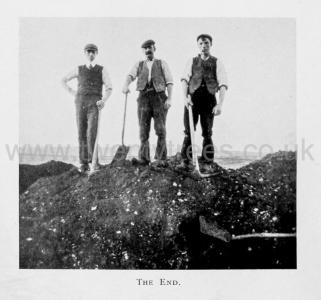 The End.
The End.
The barrow was opened by Mr. B. Howard Cunnington (age 45), F.S.A., Scot. The greater part of this paper was printed with the illustrations here given (except the arrow-head) in The Reliquary for January, 1907, vol. xiii., pp. 28-46.
The Society is indebted to Dr. Maurice, of Marlborough, in whose possession all the objects here described remain, for a donation of two guineas towards the cost of the illustrations.- Ed.J
It would be difficult to find in all England a more picturesque old place than Marlborough [Map], or one surrounded by country more charming and diversified. The great forest of Savernake with its unrivalled avenue, its magnificent timber, its lovely glades, and the wide open Wiltshire Downs, with their delightful sense of space and freedom, are both equally within reach of the lucky Marlburian. And, to give an added charm to all its beauty, the country vibrates with great historic and even greater pre-historic interests.
To speak only of these latter that have drifted down to us through the ages: there are the flint tools of mysterious paleeolithic men from the gravels of Savernake Forest, the stupendous and no less mysterious Avebury Temple and Silbury Hill [Map], the cromlechs and the barrows - derelicts stranded from the unfathomed depths of time.
It is the human element in these relics of the past that make them of such surpassing interest - even of fascination to us; they are the labours of human hands, the creations of human brains, the embodiment of the ideas and of the aspirations, the hopes and the fears of men and women like and yet unlike ourselves - our predecessors in the land, if not actually our ancestors.
Though less imposing than the greater works, the barrows are almost of greater fascination and of more poignant interest, because ill these we get the most intimate, the most touching, and the most personal and human interest. Paradoxical as it sounds, it is yet true that the burial mounds of the dead have given us almost the only glimpse we have been able to obtain into the manner and conditions of life of the people who built them, and they are the source from whence nearly all the little we know about these people has been gleaned.
A little over a mile from Marlborough, at Manton, in the parish of Preshute, and about four and a half miles in a straight line from the great temple of Avebury, there lies a barrow beautifully, but not conspicuously, situated about midway down the hillside that slopes gently with a southerly aspect to the river Kennet1. At the opening of this barrow last October (1906) it was the writer's pleasure and privilege to assist. Work was begun on October 1st, 1906, and was continued on eight days during the following fortnight, the weather interfering somewhat with its regularity. Never less than two, and sometimes three, four, and five men were employed. No digging was allowed to be done unless we ourselves were present, every spadeful was looked over as it was thrown out, and when the interment was reached we cleared the earth and removed all the relics with our own hands. To sift all the material of the barrow would have been a gigantic task, but that in the immediate vicinity of the finds was carefully sifted.
Note 1. Marked on Rev. A. C. Smith's Map, Section XV. L. VI. a, ibid, page 204. Not marked in latest Ordnance Survey Map but is on the earlier ones.
Considerable local interest was shown in the work and during the digging the barrow was seldom without visitors, many of whom much encouraged the workers by the interest they took in the work and many helpful suggestions1.
Note 1. Special thanks are due to Mr. and Mrs. Bucknall, of Plough Cottage, for the very considerable help and assistance they rendered in many ways, in addition to much personal kindness.
The barrow has suffered much through the action of the plough during the many years that it has been under cultivation, and already it could easily have escaped the notice of anyone not on the look-out for it. A few more years of continued ploughing, and all trace of its existence would have vanished for ever, and its contents have been scattered and unrecognised. The knowledge of the danger impending to any relics that it might contain doubtless influenced Dr. Blake Maurice, of Marlborough, who is the landowner, and by whose kind permission and assistance it has been opened, in his determination to have it investigated before it was too late, and archaeologists are indebted to him for his timely and considerate action. The field in which it lies is known as Barrow Field or Piece, and seems to have been so called from time immemorial. The barrow itself lies about 100 yards to the north of the Bath Road. That it should thus have imposed its name upon the land in a neighbourhood where barrows are familiar objects, and where, formerly, they were even more numerous than they are to-day, is interesting as affording evidence of its former size and importance ! it suggests that this barrow must, for some reason, have been thought of a little more consequence than most of its fellows. It recalls to mind the interesting and curious story told of the cairn near Mold, from which came the gold corselet (?) now in the British Museum1, and other tales analogous to it and equally weird. Is it possible that through the long centuries here also lingered a dim memory, enshrined in tradition, of some great deed, or of a great and loving veneration, though nothing more tangible now remains than the vague sense of interest and importance that the name implies ?
Note 1. This piece of gold armour formerly described as a corselet is now believed fo be a peytral or brunt for a pony. See British Museum Guide to the Bronze Age, p. 149; for account of the find, Archæologia, XXVI., p. 422.
A slight natural swell or undulation appears to have been taken advantage of on which to build the mound, and that, together with the levelling and contortion to which it has been subjected, gives it somewhat the appearance of a long barrow, and makes it impossible to say with any exactitude what the original size and shape of the mound had been, except that it was of the "round" barrow type, and of a very considerable size.
This large, unshapely, and scattered mound was attacked by means of a trench 4ft. wide cut from the south-westerly extremity towards the north-east, and designed to strike through its centre; subsequently other trenches were cut towards the east and south, and the whole of the central part of the barrow was thrown over in the hope, that proved futile, of finding secondary interments. To lessen the risk of objects from the ploughed surface becoming confused with the undisturbed material of the barrow, the soil to a depth of a foot was removed along this trench before the deeper digging was done. At the slighest part of the barrow the depth to the undisturbed chalk was only 3ft. 9in. Irregular layers of yellowisli colour, that appeared to be the result of burning, were noticed throughout the mound. It was suggested that these might have been caused by bush fires that had swept over the ground at times when it was covered with gorse and undergrowth, but some of the layers were too deep and all too irregular to admit readily of this explanation, unless we allow that the mound was added to at many subsequent dates. The cutting through the barrow revealed the fact that there had been an inner and an outer trench cut into the chalk encircling, or partly encircling, the mound. It would have entailed so much extra labour that the extent of these trenches was not ascertained, but the cutting on the north-eastern side showed that they were not continuous there. The trenches were about 14in. in depth, and 2ft. 9in. wide at the top, narrowing considerably towards the bottom. The inside edge of the outer trench was less than 2ft. from the outer edge of the second trench. Both the trenches or ditches are now actually just within the area of the mound, but when it was more compact and before it had been partly scattered by the plough they may well have been only on its outside margin; in its present condition it is impossible to say with accuracy quite where the barrow ends and the natural swell of the land begins1.
Note 1. Mr. J. R. Mortimer says:- "Most of the Wold barrows I have opened were found to have a filled-in trench encircling their margin, not visible on the surface, the filling in being the result of tilling the land and atmospheric influences." Burial Mounds of East Yorkshire, p. xx.
One really well worked flint arrow-head was picked up in the barrow on the old ground level, but besides this, few stray objects of interest came to light during the digging; a few worked flints such as may be picked up on the surface of the field, a few flints and pieces of sarsen stone that had been subjected to heat, a few bones and teeth of animals, and a few scattered fragments of charcoal were the only finds, in spite of a careful watch. It is somewhat remarkable that only one fragment of pottery was found in the whole barrow, and this was of doubtful age.

The interment was reached 34ft. from the beginning of the first trench. Presuming that the mound was originally circular, its diameter appears to have been about 66ft., so that the burial had taken place as nearly as possible at its centre.
Considering the mutilated condition of the barrow, there was a considerable element of good luck in the fact that the skeleton was discovered to lie exactly in the centre of the trench.
The interment proved to be that of the unburnt skeleton of an adult, lying in a crouched position, and surrounded by an unusual number and variety of grave goods.

From 1ft. to 1ft. 6in. in front of the skeleton there were about two spadefuls of clayey soil full of bones, too much broken and decayed to admit of any identification. It seems probable that this bony mass was the remnant of a food offering that had been made for the benefit of the departed; the bones had certainly been broken into pieces of a few inches in length before they had been put in the ground.
The skeleton lay on its left side with the knees drawn up to the chin, the left hand under the head the other close to the knees, and head towards the south-east- or, to be more accurate, that was the direction of the axis of the body, for the head was much bent forward and pressed down towards the breast bone.
The bones apparently all lay in their natural positions, with only such falling together and crushing as would result from decay and the pressure of the earth above. Unfortunately, they were considerably decayed, and, although their positions could be clearly traced as they lay in the ground, many of them fell at once to powder when touched. The skull had been crushed into fragments, and much of it was in a powdery condition.
The body seems to have been placed on the old ground level with no grave or cist to protect it, and without any large stones or flints round it. From the nature of the surrounding soil, however, it seems probable that the body had been completely covered over with turfs, and these may have been intended to serve, in some measure, as a protection in the absence of any other form of cist. The skeleton was at a depth of only 2ft. 6in. below the present surface, it had been so contracted as to only occupy a space 3ft. 2in. long by 2ft. wide.
The following objects were found to have been placed beside the dead, for what purpose they were there or of what they are significant, we can only conjecture. The exact positions in which they were found will be readily understood by reference to the numbers and to the accompanying sketch.
No. 1. A pommel of dark amber much decayed. On each side are two holes for rivets. It was found near, and is believed to have been the pommel to the handle of the small bronze blade number 2. Length 1⅛in.
No. 2. A small bronze blade, length 1½in.
No 3. Stud of earthenware (?) found close to neck of skeleton. Diameter 11/16 in.

 Miniature bronze knife with two rivets found with an amber pommel. Collection of [Map].
Miniature bronze knife with two rivets found with an amber pommel. Collection of [Map].
No. 4. Barrel-shaped bead of lignite, capped at each end by thin gold caps and encircled by three gold bands. Each cap and each band has three parallel lines engraved round it. The core has incised lines encircling it corresponding to the lines on the gold. The bead has a hole bored through it very large in proportion to its size, the diameter of the hole being ¼ of an inch, or nearly half of the diameter of the bead. The edges of the caps are beaten over inside the hole1. Diameter of bead ⅝in.
Note 1. For a similar bead see Ancient Wilts, p. 202. Stourhead Cat., No. 140. Also from Bircham, in Norfolk. Proc. Soc. Antiq., Second Series, vol. iv., p. 456.

 Gold-bound shale bead encompassed by 5 bands, each engraved with 3 grooves. Collection of [Map].
Gold-bound shale bead encompassed by 5 bands, each engraved with 3 grooves. Collection of [Map].
No. 5. A disc of red amber framed in borders of thin gold. The gold borders are engraved with six concentric accurately drawn lines. There are a number of depressed dots placed with great care at regular intervals of 1/32 of an inch apart in the lines. Both sides are alike, and the disc is slightly convex, the rim being 3/32 of an inch in thickness and has two parallel incised lines round it. The two borders are separate pieces of gold, and one of the lines round the rim has been taken advantage of to join the two together; so skilfully has this been done that in some places the join is not easy to detect. There are two holes bored in the rim, and these seem to have been in connection with some arrangement for suspension. Diameter of disc 15/16 of an inch.

 Gold-mounted amber disk. Collection of [Map].
Gold-mounted amber disk. Collection of [Map].
No. 6. A "Lancet." It consists now of two hollow oblong sheaths of thin gold, into one of which is inserted a small bronze blade. When complete, this curious little instrument probably consisted of a core of wood into which was inserted the bronze blade, the wood being encased in the thin sheaths of gold. The smaller - or handle - end has two holes for rivets, evidently intended to fasten the gold securely on to the wooden core; the other sheath has no rivet holes, but was probably kept in place by means of the Idade. There is no doubt as to the relative position of the two sheaths, they were found lying exactly as here represented, touching each other, with the little bronze blade still in place. The blade has no appearance of ever having been broken, but is of the original size and shape. The smaller - or handle - end is enriched by bands of incised lines; each band has three lines, and there are five bands. The blade end is similarly treated, but there are seven bands instead of five. The lines are drawn with great precision. Length respectively of sheaths ½in. and ⅝in.
No. 6a. End of sheath showing rivet holes.

 Miniature bronze halbard with gold haft engraved with 12 bands of 3 lines. Collection of [Map].
Miniature bronze halbard with gold haft engraved with 12 bands of 3 lines. Collection of [Map].
No. 7. One hundred and fifty small fiat circular beads of jet or shale (only one hundred and forty-four are represented here, as six are preserved in a piece of clay, as found1.
No. 7a. Largest bead.
No. 7b. Smallest bead.
No. 7c. Fossil encrinite used as a bead.
Note 1. Beads apparently identical with these have been found, by Canon Greenwell (age 86), British Barrows, p. 419, fig. 159; by J. K. Mortimer, "Burials Mounds of East Yorkshire," p. 138, Pl. XLIV.; ibid, p. 223, Pl. LXXVII.; and at Lake, Ancient Wilts, p. 210, Stourhead Cat., No. 172b.
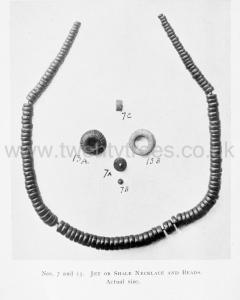
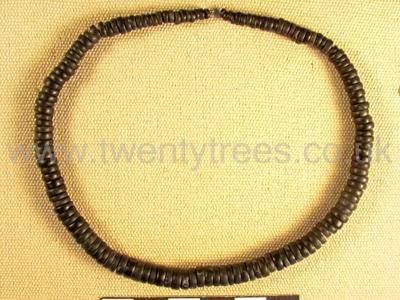 150 shale beads from a shale bead necklace. Collection of [Map].
150 shale beads from a shale bead necklace. Collection of [Map].
No. 8. Five small much decayed amber beads. Not illustrated.
No. 9. Small square tanged bronze awl, length 2in.
No. 10. Small tanged bronze awl. Curiously the two points are in wonderful preservation and quite sharp, while the central part is much decayed. Length 1⅝in.
No. 11. Tanged awl of bronze, length 3¼in.
No. 12. Small bronze dagger blade. It is too much corroded to see any ornamentation if it ever had any. The two rivets are still in it. Length 1¾in.
No. 13. Three beads found together at the feet of the skeleton. 14a is of black shale or jet, and fluted; 13b is of some pinkish substance resembling soft stone1. It is irregularly shaped, and has such a large perforation as to be almost better described as a ring tlian as a bead; the third is white and very soft and fragile, and much resembles chalk in substance. This last was in fragments and is not illustrated.
Note 1. See Stourhead Cat., No. 173, and Ancient Wilts, p. 211, for an identical bead from Lake.

 Ribbed shale bead. Collection of [Map].
Ribbed shale bead. Collection of [Map].
No. 14. A perfect specimen of a "Grape" Cup. It has five rows of knobs, and seventeen small perforations or holes pierced through and these are pierced at irregular distances. The perforations are placed between the second row of knobs, and as the knobs are not very regular, a hole seems to have been made only between such as aftbrded a convenient space. The ware is brownish outside, but where chipped it shows quite black. Height 2⅛in., rim diameter 2in., base diameter 2¼in.
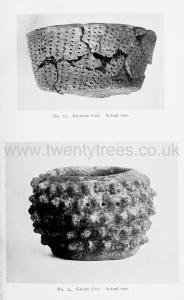
 Miniature (incense) or 'grape' cup with one line of perforations around waist and decorated with 5 rows of nodules and an inwardly curving rim. Collection of [Map].
Miniature (incense) or 'grape' cup with one line of perforations around waist and decorated with 5 rows of nodules and an inwardly curving rim. Collection of [Map].
No. 15. This small rude cup-like vase should perhaps be classed as belonging to the type known as "incense cups". It is decorated with a series of small oblong punctures in would-be vertical rows, the rows are fairly straight at first, but the artist seems soon to have got into difficulties, and the lines become increasingly slanting until they are at such an angle that they never reach the bottom at all, and are allowed half-way down the side to merge into the other lines. The more perfect portion of the rim is J of an inch in width, and has been decorated with a chevron pattern of lines drawn from edge to edge; the triangular spaces between the lines have punctured dots in them, and these dots and lines appear to have been filled in with some white stuff as if for the purpose of making the pattern stand out more clearly. Canon Greenwell (age 86) mentions a somewhat similar case, where a pattern seems to have been emphasised by means of a white substance filling in the lines on an incense cup from a barrow at Aldbourne, Wilts1. One half of the cup is much more crumbly and decayed than the other; from this part the white filling is absent and the edges are blackened as if it had been in a fire, and more affected by it on one side than the other. It would seem that the crudeness of the ornamentation could only have been the result of sheer carelessness, or of an intelligence and skill equal to that of a child.
Archæogia, LII., p. 53. The same peculiarity may be seen on a drinking cup from Roundway Down, in the Museum at Devizes.

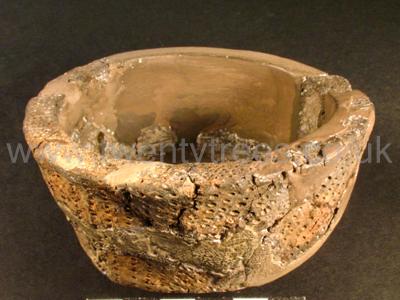 Miniature (incense) cup with vertical and diagonal lines of impressed dots around body, and forming zig-zags around rim. Collection of [Map].
Miniature (incense) cup with vertical and diagonal lines of impressed dots around body, and forming zig-zags around rim. Collection of [Map].
No. 16. Piece of clay showing impressed pattern of cloth.
No. 17. Nine feet almost due south of the skeleton and 1ft. 2in. below the present surface, a vessel of the cinerary urn type was disclosed. It had been crushed into several pieces by the weight of the earth above, and was also slightly damaged by the workman's pick; it has, however, been repaired and is now complete. It stood in an upright position, but with no signs of ashes or of burnt material of any sort inside it, nor was there any sign of an interment, burnt or unburnt, near it1. Immediately beneath it the earth was a little reddened and discoloured as if by fire, and there were a few specks of charcoal; but the traces of fire were slight, and quite local. The vessel might be chosen as typical of a cinerary urn from its general shape and heavy overhanging rim, which latter feature Canon Greenwell (age 86) says may be regarded as the principal characteristic of this class of urn2. But in spite of its form, as it contained no bones or ashes, one is forced to the conclusion that it may have served the purpose of a food vessel, and that it had probably contained some form of food offering made to the dead at some time subsequent to the burial, and during or after the piling up of the barrow.
Note 1. Canon Greenwell (age 86) says: "In a few instances a sepulchral vase has occurred in a barrow not in close proximity with any interment," British Barrows, p. 61.
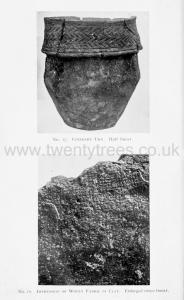
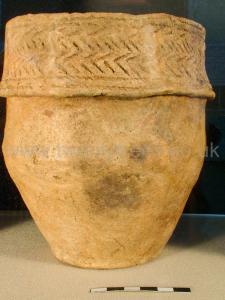 Collared urn decorated with vertical lines around rim and 2 rows of cord impressed chevrons around collar bordered by two cord impressed lines at top and bottom, found upright in cist with no cremated remains. Collection of [Map].
Collared urn decorated with vertical lines around rim and 2 rows of cord impressed chevrons around collar bordered by two cord impressed lines at top and bottom, found upright in cist with no cremated remains. Collection of [Map].
There are several recorded instances where urns of a characteristic cinerary type have apparently been used to contain food offerings instead of the more usual form of food vessel or drinking cup2; there are also instances where the food offering appears to have been placed at a considerable distance from the resting-place of him to whose service it was dedicated3.
Note 2. "On Langton Wold, and in a few cases, a vessel which is in every respect of form and ornament a cinerary urn was placed close to an unburnt body, "British Barrows, p. 62. "Not infrequently a food vessel is of the cinerary urn type, though its size is that of an ordinary food vessel. And in rare instances a real cinerary urn, both in size and type, seems to have been used as a food vessel, and placed near a heap of burnt bones, and not containing them," J. E. Mortimer, Burial Mounds of East Yorkshire, p. liv.
Note 3. Mr. J. R. Mortimer says:- "We have in several instances found vases which had every appearance of having been deposited with food in them, where no trace of an interment could be discovered," Burial Mounds of East Yorkshire, p. 55 (note); see also ibid,pp.l07. 314 (Barrow 247), 316 (Barrow 250), 323 (barrow c. 90.)
About a foot beneath the urn there were a few broken and much decayed bones, about one-half in quantity and similar in character to those found in front of the skeleton; this gave rise to the hope that there was another interment somewhere near, but the hope proved groundless, and it seems possible that this had also been a food offering of a date later than that of the burial.
The Grape Cup was found behind the neck within a few inches of the shoulders - so close, indeed, that some of the vertebrae had to be disturljed before it could be removed with safety. It was lying on its side tilted towards the skeleton; it had, however, probably been placed in an upright position, and only tilted forward as the bones collapsed.
The incense cup was also at the back of the skeleton; it was 1ft. to 1½ft. behind the Grape Cup on a slightly higher level, and apparently must have been placed there after the body had been at least partially buried.
The dagger blade lay some 3in. in front of the feet. Vestiges of its wooden handle were discernible, and fragments of the wood still adhered to the rivets. The handle had been about 4in. in length, and thus only long enough to admit of its being grasped in the hand. The three bronze awls were close together behind the dagger, to the front of which were the three single beads. The stud was near the chin, in such a position as at once to suggest that it had been used to fasten a garment of some sort round the neck.
Lying near each other and from 6in. to 8in. from the head were the disc of gold and amber, the spherical bead, the gold-handled lancet, a small bronze blade and amber pommel, and the jet and amber beads. The beads had certainly been threaded together, and lay in rows embedded in the clay; the rows lay over one another as though the string of beads had been deposited in a little heap and not laid out in any order. They were not round the neck. Some of the beads were stained with bronze from actual contact with the small bronze blade.
The ground immediately above and beneath the skeleton was of a clayey and highly tenacious substance, and very favourable for receiving and retaining impressions. This clay was first loosened with a small sharp mason's trowel, and then removed with the hand. On the clay that had been in contact with the skeleton, both on the upper and the under side, a distinctly reticulated pattern was quite plainly visible. Apparently the body had been wrapped in some coarsely woven material, and though nearly every particle of this cloth had disappeared, a visible proof of its former presence was afforded by the impression that its threads had left on the tell-tale clay. A minute fragment or two of the actual cloth, or rather casts of the cloth, formed by the deposit of carbonate of lime, have been preserved1.
Note 1. For linen in Bronze Age barrows Wilts Arch. Mag., xxi., p. 261 and 346. Stourhead Cat., No. 205; Ancient Wilts, pp. 168, 169, and 242; Proceedings of Society of Antiquaries of Scotland, xxxix. (1904-5), p. 552; Burial Mounds of East Yorkshire, pp. 234, 275; Archceologia, XXXIV p 255
The impress of the cloth extended beyond the head, and whether placed there singly or as forming part of a head-dress, the objects described as found together by the head were also within the area of the cloth. There were vestiges of wood round the head, and in places the fibre of the wood could be seen resting on the impress of the cloth. Of what extent this wood had been, and what its purpose, it was not found possible to determine; it might have have been a piece of wood placed over and about the head possibly witli the idea of protection to it and to the accompanying relics. It was interesting to notice that there had been two qualities of cloth used, one considerably coarser than the other, and it is mainly of the coarser one that fragments are preserved.
On removing the bones it was noticed that the ground immediately beneath the skeleton and about the head was stained a reddish colour. Dr. C. W. Cunnington, of Hampstead, has kindly analysed the incrustation and finds it to be the hydratio peroxide of iron. Mr. T. H. Powell, of Denmark Hill, to whom also a specimen was submitted, has kindly reported as follows:- "I have examined the red stain under the microscope and can detect signs of wood structure, and think, therefore, the rest has completely decayed, except where the tissue has been replaced by iron rust; it might be all that is left of a flaxen garment, but I managed to' detach one or two small fragments which are rather too thick. Iron oxide has the property of replacing, and thus coarsely preserving wood and such like tissue (vegetable) and often forms a sort of cement. The stain is iron oxide. I have tested it chemically. If the barrow was on top of the chalk, the clay would certainly be highly ferrugineous, and the stain might very probably have been derived direct from the chalk."
The wood fibre detected by Mr. Powell came from about the head, and his report thus satisfactorily accounts for the red incrustation; the vegetable fibre of the garment round the body (linen) and the wood about the head had been to some extent replaced by iron oxide from the surrounding clay, thus forming a layer or incrustation of red colour.
Previous to this discovery there seem to have been only six recorded finds of Grape Cups1. They were so named by Sir R. Colt Hoare, and re-named "nodulated cups" by Dr. Thurnam2, who included among their number a small rude cup, now in the Museum at Devizes3, which though nodulated, can by no stretch of the imagination be classed as a Grape Cup. Four of these cups are in the Museum at Devizes, one is in the Bristol Museum, and one has been lost sight of. With the exception of the one at Bristol that was found in a barrow at Priddy, in the neighbouring county of Somerset, they have all been found in Wiltshire barrows.
Upton Lovel Golden Barrow, with burnt interment. Ancient Wilts, p. 99, at Devizes; Amesbury, barrow 133, burnt, ibid, p. 199, at Devizes; Normanton, barrow 156, unburnt, ibid, p. 202, at Devizes. Barrow on Windmill Hill, near Avebury, see Rev. A. C. Smith's Map, Section VI., F. IV.b., unburnt interment; Arch. Instit., Salisbury, p. 108. at Devizes. Barrow south-east of Kennet, unburnt interment, LOST. Diary of a Dean, p. 44 [02 Aug], fig. 2. Barrow near Priddy, burnt interment, at Bristol Museum, Arch. Journ., XVI., p. 149. Of the seven grape cups now known it will be seen that three were with burnt and four with unburnt burials.
Note 2. Archœologia, XLIII., p. 364.
Note 3. Stourhead Cat., No. 187.
It is just a hundred years ago since the last recorded find of gold in a Bronze Age barrow in Wiltshire1, and the present one makes only the eighth similar find in the county, while in the whole of the rest of England and Wales there have been scarcely as many more. Five of the gold-bearing barrows were on Salisbury Plain - one close to its edge at Upton Lovel in the valley of the Wyly, and one at Mere in the extreme west of the county, about eight miles in a straight line from Upton Lovel2. All these were in South Wilts, and Dr. Thurnam remarks "no objects of the precious metal are found in the barrows in North Wilts." This find at Manton seems to be the first exception to the rule.
Note 1. Upton Lovel Golden Barrow, Hoare and Cunnington, 1803, re-opened, with further finds, in 1807.
Note 1. Upton Lovel Golden Barrow, burnt interment, Ancient Wilts, p. 202;
Note 2-Normanton barrow 155, burnt, ibid, p. 201;
Note 3-Normanton, barrow 156, unburnt, ibid, p. 202;
Note 4-Normanton Bush Barrow [Map], 158, unburnt, ibid, unburnt, ibid p. 202;
Note 5. Mere Down, unburnt, ibid, p. 44;
Note 6-Lake, barrow 21, unburnt, ibid, p. 213;
Note 7. Stonehenge barrow, burnt, Stukeley's "Stonehenge, pp. 44-62;
Note 8-Manton.
Although all these golden barrows have striking points of resemblance to each other, and doubtless belong to the same people and period, there seems to be no kind of rule as to the mode of burial, three being by cremation and five by inhumation.
It is worthy of note that, while only seven Grape Cups are known to have been found, and only eight Wiltshire barrows have contained gold, in three cases the Grape Cup and the gold were found associated in the same barrow1.
Note 1. Ancient Wilts, barrows Nos. 40 and 156, and at Manton.
There are in the Museum at Devizes two pendants1 that came from a barrow on Salisbury Plain strikingly similar to the one found at Manton- indeed, so alike are they that it seems possible that they were made by the same hands; the only difference appears to be that those from the Plain are slightly larger, being liin. in diameter, and that instead of the lines of ornamentation being equidistant they are arranged in two bands. The arrangement of the holes for suspension and the dotted lines are identical. A pair of similar pendants now in the British Museum also came from a Wiltshire barrow2. These are covered with a thin casing of gold, but what the centre is made of is not stated; they are ornamented with a zigzag or chevron pattern. These pendants are usually, but not invariably, found in pairs. Stukeley records the finding of a single one, and describes it as a "button-like object completely covered with a film of thin gold," with a core of what he calls "earth," but what Dr. Thurnam suggests was really decayed amber3. In other instances somewhat similar pendants have been been found singly4: these pendants have been described as "ear-rings," but it is at least equally probable that they were worn round the neck or on the breast, or even on the forehead, and that their form may be symbolical - possilbly of Sun worship. They have been so rarely met with, and then always with interments of evident wealth and importance, that it seems not unreasonable to suggest that they may have been symbolical badges of some sort.
Note 1. Ancient Wilts, p. 201. Stourhead Cat., No. 134.
Note 2. Ancient Wilts, p. 213, Lake, barrow No. 21.
Note 3. Archœologia, XLIII., p. 526, note e.
Note 4. Ancient Wilts, p. 202, Pl. XXV., No. 156. Ibid. barrow 155. Proceedings of Society of Antiquaries of Scotland, vol. XXI. (1886-7), p. 316. Also Catalogue of National Museum at Edinburgh, E. Q. 198, 200.
The "lancet" (No. 6) is perhaps the most interesting and unusual of all the Manton barrow finds. The only thing at all similar to it of which there seems to be any record came from the same barrow as the pendants in the Museum at Devizes referred to above, and is also in that Museum." In this case the small bronze blade is let into a piece of dark amber, which is bound round with, four fillets of gold. These curious little cutting instruments may have been used in a ceremonial rite of some kind, or be symbolical of one so used. It is a curious coincidence that these two "lancets" should liave been found with nearly identical pendants of gold and amber. It would be intensely interesting, and perhaps throw a flood of light on the culture and beliefs of the Bronze Age, could we but read the riddle of these things aright.

The constant occurrence of the number three is interesting: on the disc No. 5 the concentric circles are divisible by three, the lines on the bands of ornament on the spherical bead are in threes, as are also those on the gold-handled lancet; there were three beads of difterent colours and materials placed certainly not without some distinct intention at the feet of the skeleton, and together with these were the three bronze awls - differing and yet alike in their general character.
A small fragment of a stone unlike anything else found in the barrow was thrown out in a spadeful of soil from about the old ground level in the north-eastern trench. The fragment measures one and one-tenth of an inch by four-fifths; the greatest thickness being two-fifths. One surface is smooth, polished, and slightly concave, whilst the others are rough and uneven. Mr. N. Story Maskelyne, to whom it was submitted, kindly procured its microscopical examination by Mr. Fletcher, Keeper of the Mineral Department of the British Museum, and by Mr. Prior, of that department.
Mr. Story Maskelyne writes as follows:-
"Mr. Fletcher tells me that he has looked through the sections of many rocks resembling it, and so far finds the nearest to it in a metamorphosed basaltic rock from the neighbourhood of Penzance. Of course, as he observes, there may be places in Devon and elsewhere where such a rock may be found. It is clear that it is not a Wiltshire rock at all. A petrological account of it as seen in the section describes it as consisting of a fibrous hornblende with strings of opacite and a small amount of felspar. Opacite is a name given to a substance occurring in rocks of probably variable composition, and so, indefinite in character, and opaque under the microscope. Of course if Professor Judd is right in imagining drift to have been in this part of Wilts and near Stonehenge, the stone may have come from somewhere in company with other drift stones. If that were so it is very singular that not a speck of such material remained anywhere on the ground or in walls, and that they only have been met with in Stonehenge and in sepulchral tumuli, and in this case with a worked surface."
As there were no signs of recent fracture and no other similar stone could be found it is probable that this broken fragment found its way alone and accidentally into the barrow.
The Rev. E. H. Goddard has suggested that the form and character of the fragment make it very probable that it is a chip off the upper or under side of a hammer-axe. Mr. Goddard points out that celts made of a somewhat similar stone have been found elsewhere in Wilts, and that in the Stourhead Collection there are five perforated axes or hammer axes from the barrows of South Wilts all made of igneous and non-Wiltshire rocks, so that it is quite likely that the builders of the barrow had implements of this material. It seems likely that this piece of a hammer-axe, if such it be, like other implements of the kind found in Wilts, must have been an object of barter and traded from the distant source of its natural origin. Indeed many interesting inferences may be drawn from the contents of this barrow as to the extent of trading among the people of the bronze age in Britain. The gold, amber, lignite, shale or jet, the tin and copper for the bronze, if not the manufactured bronze itself, must have been brought from varied and widely separated districts. The delicate and beautiful workmansliip of the gold and other ornaments is in curious contrast with the rude and clumsy art of the home-made pottery of the period, none of which is wheel-turned. The pefectly barrel-like bead (Fig. 6), encircled as it is with accurately drawn incised lines, suggests lathe work, and the engraved concentric circles on the disk (Fig. 7) a compass of some sort. Could the bead be shaped so well without a lathe or wheel of some kind to turn it on ? If not, the presumption is strongly in favour of its having been traded into Britain as a manufactured article, because if the principle of wheel-turning was known to these barrow builders, it seems unlikely that such ingenious people would not have applied its use to some at least of their pottery. It seems at least open to doubt whether these more skilfully worked objects of rarity and value, such as gold, amber, and lignite, were made in Britain.

It was in one sense disappointing not to find more than one interment in the whole of this large barrow, but, on the other hand, the absence of any other is in itself suggestive, and lends itself to much interesting if not very profitable conjecture. It is just possible that there may have been others, and that they have been ploughed out, a fate that not uncommonly overtakes burials in the more superficial parts of barrows; but as the whole of the centre of the mound was turned over without result, any other burial, if one ever took place within it, could not have been in very close association with the first.
Professor Fawcett, in conjunction with Professor Reynolds, of University College, Bristol, have kindly identified the bones and teeth of animals found during the excavation of the barrow. The bones are those of the ox, sheep, deer, pig, and fox; the teeth those of the ox, pig, and fox. The bones are few in number and fragmentary. Those of the sheep are much smaller than those of most breeds of modern sheep. The bones and teeth were, with the exception of the fox, found singly throughout the barrow, and their presence there seems to have been quite accidental. Two of the pig's teeth and several of those of the ox were found on the old ground level, and must have been lying there wlien the barrow was built; the others were probably thrown in with the soil when the mound was piled up. The bones of the fox were all found together and are the remains of one skeleton . They were only a foot to sixteen inches below the present surface, and possibly - even probably - have no antiquarian interest. It is quite likely that at some time when the ground was uncultivated and covered with scrub there was a hole or burrow there into which the creature crawled and died.
The bones of the human skeleton were rather small and slender, but with strong muscular attachments. The individual had suffered from rheumatic arthritis, and had a remarkable and uncommon malformation of the nasal bones.
Dr. Beddoe has kindly made the following report on the skull and the measurements of the bones as submitted to him:-
Bradford-on-Avon,
October 26th, 1906.
"With reference to the human bones from a barrow near Marlborough which Mr. Cunnington has kindly given me an opportunity of examining, I am of opinion that they probably belonged to a female of considerable age. I base this opinion on the apparent small size of the cranium, the absence of prominent development of the supraciliary arches and of the muscular attachments, and the moderate stature, as deduced from the lengths of the humerus and the femur. The humerus, if, as reported to me1, 12.5 inches in maximum length, would, if masculine, indicate a stature of 63.9 by Manouvrier's scale, but if feminine, of 62.8 inches. Pearson's figures would be 64 and 62.8 inches. The femur, of 17¾ inches, or 451 mm's, would yield by Manouvrier's scale 65.1 inches, or 63.6, but by Pearson's 65.4 if masculine, and 64 if feminine. The skull is not capable of being satisfactorily recomposed, but it appears to have been elliptic and mesocephalic: the greatest length may have been about 160 millimetres; the breadth, yet more difficult to estimate, may have been 130 or a little more. The bones are rather thick for a female skull. The teeth are a good deal worn down by hard food; the mandible strong and the angle not very obtuse.
Dr. Poynton, who saw the skeleton before it had been in any way disturbed, kindly measured the bones as they lay in the ground, because from their decayed condition they would not bear moving without breaking.
On the whole, I conjecture that these remains belonged to a woman of considerable age, and that their period was somewhere during the latter portion of the Bronze Age.
John Beddoe.
Canon Green well has kindly expressed it as his opinion that the articles found in association with the skeleton certainly point to its being that of a woman buried with her appliances for domestic use. He regards the ornaments as those of feminine adornment, the bronze awls as prickers perhaps used for boring holes to draw the threads throngh in sewing, the bi'onze blades not as daggers but as knives, as was probably the so-called lancet.
All the relics are now in the safe keeping of Dr. Blake Maurice, at Marlborough. It should be added that is the intention of Dr. Blake Maurice to re-inter the skeleton, and to rebuild the mound and to plant it with trees, so that in future it shall be held sacred from the plough and still be dedicated to the memory of one who, though now nameless, must once have been numbered among the illustrious in the land.
Manton Barrow aka Preshute G1a [Map] is a Bronze Age Round Barrow excavated by Howard B. Cunnington and Maud Cunnington née Pegge who discovered a number of significant artefacts including gold artfacts. See Wiltshire Archaeological Magazine 1907 V35 Pages 1-20.
